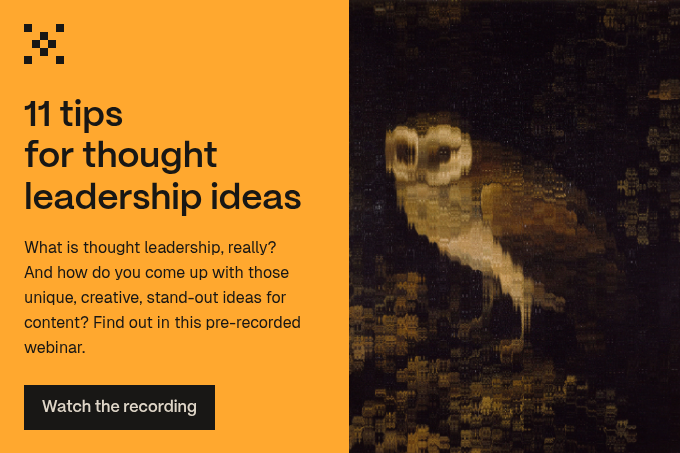Nobody writes letters anymore. But maybe they should. The anticipation, the ripping of the envelope (with your finger because a knife’s never to hand), the smell and feel of the paper, the unique scrawl of your correspondent – letters pack a punch.
Yet dead it is; its grave dug and filled in by the likes of text, email and instant messaging.
But while the art might be dead, the lessons great letter writers have to teach are timeless and they apply to all forms of communication.
Lesson 1: hook the reader
EB White, a hero of ours, wrote the following:
September 28, 1956
Dear Mr. Adams:
Thanks for your letter inviting me to join the committee of the Arts and Sciences for Eisenhower.
I muse decline, for secret reasons.
Sincerely,
E. B. White
Good writing needs a hook – something to grab the reader. White, with a bit of fun and mystery, pulls it off here with aplomb.
Lesson 2: make it simple, not simplistic
Weeks before the discovery was made public, Francis Crick wrote a letter to his 12-year-old son detailing his and James Watson’s breakthrough regarding the structure of DNA.
DNA is a complex molecule, yet Crick explained it simply and clearly, using short sentences, plain English and visual language, interspersed with roughly drawn diagrams.
One line runs: ‘Our structure is very beautiful. D.N.A. can be thought of roughly as a very long chain with flat bits sticking out.’
If Crick can describe the complexity of deoxyribonucleic acid in a way a child can understand, why do so many companies insist on obfuscating their mission statements, products and services with corporate jargon and other meaningless drivel?
Just because something is complicated or technical doesn’t mean the description of it has to be boring, opaque or wrapped up in long words.
Lesson 3: language is a toolkit, use it
That said, in the right context, fancy words are the order of the day – the right word can evoke colour, texture, rhythm, and might even land you a job, as they did for copywriter and screenwriter Robert Pirosh:
Dear Sir:
I like words. I like fat buttery words, such as ooze, turpitude, glutinous, toady. I like solemn, angular, creaky words, such as straitlaced, cantankerous, pecunious, valedictory. I like spurious, black-is-white words, such as mortician, liquidate, tonsorial, demi-monde. I like suave ‘V’ words, such as Svengali, svelte, bravura, verve. I like crunchy, brittle, crackly words, such as splinter, grapple, jostle, crusty. I like sullen, crabbed, scowling words, such as skulk, glower, scabby, churl. I like Oh-Heavens, my-gracious, land's-sake words, such as tricksy, tucker, genteel, horrid. I like elegant, flowery words, such as estivate, peregrinate, elysium, halcyon. I like wormy, squirmy, mealy words, such as crawl, blubber, squeal, drip. I like sniggly, chuckling words, such as cowlick, gurgle, bubble and burp.
I like the word screenwriter better than copywriter, so I decided to quit my job in a New York advertising agency and try my luck in Hollywood, but before taking the plunge I went to Europe for a year of study, contemplation and horsing around.
I have just returned and I still like words.
May I have a few with you?
Lesson 4: have fun
In another humorous epistle, HG Wells, writing to the Mayor of Cambridge after mistakenly taking the Mayor's hat, demonstrates the power of well-placed humour and subtle word play.
My dear Mayor:
I stole your hat. I like your hat. I shall keep your hat. Whenever I look inside it I shall think of you and your excellent dry sherry, and of the town of Cambridge, which is older than the university. I take off my hat to you.
H. G. Wells
‘I take off your hat to you.’ Brilliant.
Lesson 5: be helpful
The best content is positive and helpful, educating the reader and giving them something to take away.
Take John Kricfalusi’s (creator of the cartoon Ren & Stimpy) lengthy, supportive response to a 14-year-old aspiring cartoonist.
Packed with encouragement, advice and illustrations, and accompanied by a book by animator Preston Blair, Kricfalusi’s letter showed how much respect he had for his reader – a must in any sort of writing.
Good drawing is more important than anything else in animation. More than ideas, style, stories. Everything starts with good drawing. Learn to draw construction, perspective.
Ok, now it’s up to you.
Lesson 6: keep it short and to the point
As the Vietnam War drew to a close and the US evacuated people from South Vietnam, the USS Midway was dropped a note (weighed down by a pistol) from a small two-seat Cessna O-1 Bird Dog that was suddenly circling above the ship.
The pilot of the plane was South Vietnamese Air Force Major Buang-Ly, accompanied by his wife and five children. He was running out of fuel and intent on landing, but needed the ship to clear its runway of Huey helicopters.
So Captain Larry Chambers ordered his men to push as many of the helicopters off the deck as they could, making room for Buang-Ly to land, which he did, safe and sound, to rapturous applause.
The message that hit the deck read:
Can you move the Helicopter to the other side, I can land on your runway, I can fly 1 hour more, we have enough time to mouve. Please rescue me.
Major Bung, wife and 5 child
Now that’s a call to action.
Hat tip to William Arthur for the photo, and Letters of Note for the letters (except those by White and Wells).





.jpg?width=400&height=250&name=europeana-KG61l7RNWBs-unsplash%201%20(1).jpg)
